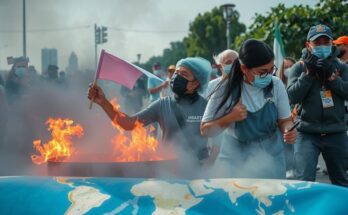Kinshasa is Africa’s most densely populated megacity with 17 million residents, overshadowing cities like New York. The city, rich in culture and economic activity, faces challenges like rapid growth leading to overcrowding and food scarcity. As a tropical metropolis, it features diverse neighborhoods and a vibrant music scene, marking its significance on the continent.
Kinshasa, the capital of the Democratic Republic of the Congo (DRC), is distinguished as Africa’s most densely populated megacity, boasting a staggering population of 17 million—over double that of New York City. This metropolis, located on the southern bank of the Congo River, displays a diverse skyline, blending high-rise apartments and luxurious villas with extensive neighborhoods characterized by tin-roofed houses. Kinshasa’s rapid urban expansion continues to attract individuals from rural areas in search of better livelihoods, although this growth has precipitated challenges such as food shortages and overcrowding.
As the largest city in the DRC, Kinshasa also functions as the nation’s economic, political, and cultural center. It is a significant hub for telecommunications, banking, and manufacturing, and is renowned for its vibrant music scene, particularly the popular Soukous dance genre that incorporates Cuban influences. Remarkably, across the Congo River lies Brazzaville, the capital of the Republic of the Congo, forming the closest pair of capital cities globally, separated by merely two miles without a bridge connecting them.
Kinshasa features a tropical climate, characterized by consistent warmth year-round. The city experiences a rainy season from October to May, during which rainstorms, although brief, are prevalent. The month of April is typically the hottest, averaging 32°C, while July remains the coolest month with average temperatures around 27°C. Spanning nearly 10,000 square kilometers, Kinshasa encloses neighborhoods that range from affluent areas like Gombe, known for housing embassies and government offices, to poorer regions in the south. For those contemplating a visit, the British government has issued pertinent travel advice regarding Kinshasa.
The phenomenon of megacities, characterized by vast populations and rapid urbanization, is often associated with major global cities such as London and New York. However, the African continent is home to several megacities that exhibit high population densities. Kinshasa, with its unique sociocultural landscape, economic significance, and challenges arising from rapid population growth, exemplifies the complexities of urban life in Africa. Understanding Kinshasa’s growth and the dynamics within can provide insights into broader trends of urbanization on the continent.
In summary, Kinshasa is a remarkable megacity, reflecting the complexities and challenges of urban life in Africa. With a population surpassing 17 million, it is not only the capital of the DRC but also a center of economic, political, and cultural activity. Despite its vibrancy and opportunities, the city grapples with tangible issues such as overcrowding and food scarcity, underscoring the need for sustainable urban development strategies.
Original Source: www.the-express.com




